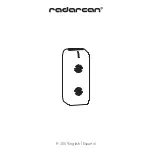
L-DALI User Manual
171
LOYTEC
Version 5.2
LOYTEC electronics GmbH
Data objects in the import folder are not stored on the device when the project is
downloaded. They represent data objects which are available on remote devices
and are shown here as templates to create suitable data objects for use on the
device by selecting the
Use on Device
option.
L-DALI
: This is the device folder of the L-DALI. It contains all the necessary data
points which constitute to the L-DALI’s port interface definition. These data points are
created on the L-DALI when the configuration is downloaded. The subfolders represent
o
Favorites
: This folder contains freely configurable symbolic links to data
points, which may reside anywhere in the folder structure. This folder
represents a way to assemble an alternate logical view to the data point
hierarchy. This folder is also available on the Web UI or the LCD UI.
o
System Registers
: This folder contains system registers, which provide
information on the device itself.
o
User Registers
: This folder holds user-definable registers. These registers are
not visible on the underlying network and are intended for internal usage.
o
Scheduler
: This folder contains generic scheduler and calendar objects. These
provide technology-independent scheduling functionality. Any data point can
be alarmed using a generic scheduler object.
o
Alarm
: This folder contains generic alarm servers. These provide technology-
independent alarms. Any data point can be alarmed using a generic alarm
server.
o
Trend
: This folder contains generic trend log objects. These can record
historical values for any data points.
o
CEA709 DALI Channel X (LDALI-10X only)
: These folders contain data
points, schedulers, calendars, trend logs, and alarm servers of the CEA-709
network technology representing the different DALI channels. There is one
subfolder of this type for each DALI channel available on the L-DALI device.
See Section 7.7.2.
o
BACnet Port (LDALI-20X only)
: This folder contains data points,
schedulers, calendars, trend logs, statistics, and remote data points of the
BACnet network technology. See Section 7.7.2.
Global Objects
: This top-level folder contains sub-folders that organize specific
application objects that operate on data points.
o
E-Mail Configuration
: This folder contains e-mail templates. An e-mail
template defines the destination address and text body of an e-mail, which is
triggered by data points and may contain data point values or file attachments.
To create an e-mail template, select the folder and use the context menu (see
Section 7.7.12).
o
Math Objects Configuration
: This folder contains math objects. Math
objects are used to perform a predefined calculation on a number of input data
points and write the result to a defined set of output data points. Each math
object contains one formula. To create a math object, select the folder and use
the context menu (see Section 6.2).
o
Alarm Log Configuration
: This folder contains the alarm log objects. Each
alarm log object creates a historical log of alarm transitions of one or more
alarm objects (alarm server or client). To create an alarm log, select the folder
and use the context menu (see Section 7.12.4).
Using the context menu on a folder, sub-folders may be created to organize the available
objects. If new objects are created automatically, they are usually placed in the base folder
and can then be moved by the user to any of his sub-folders. Note, that the folder structure
described above cannot be changed by adding or deleting folders at that level.
















































